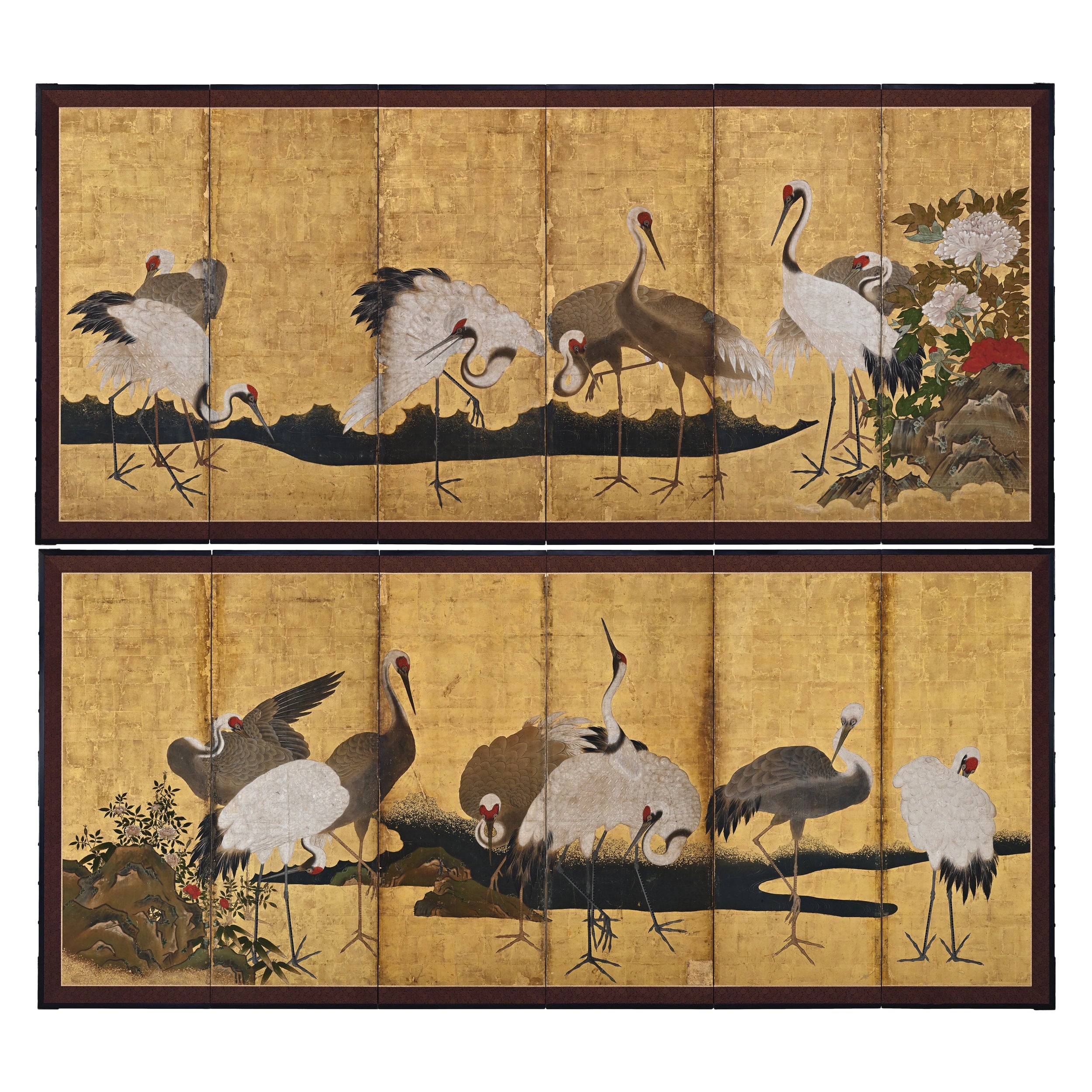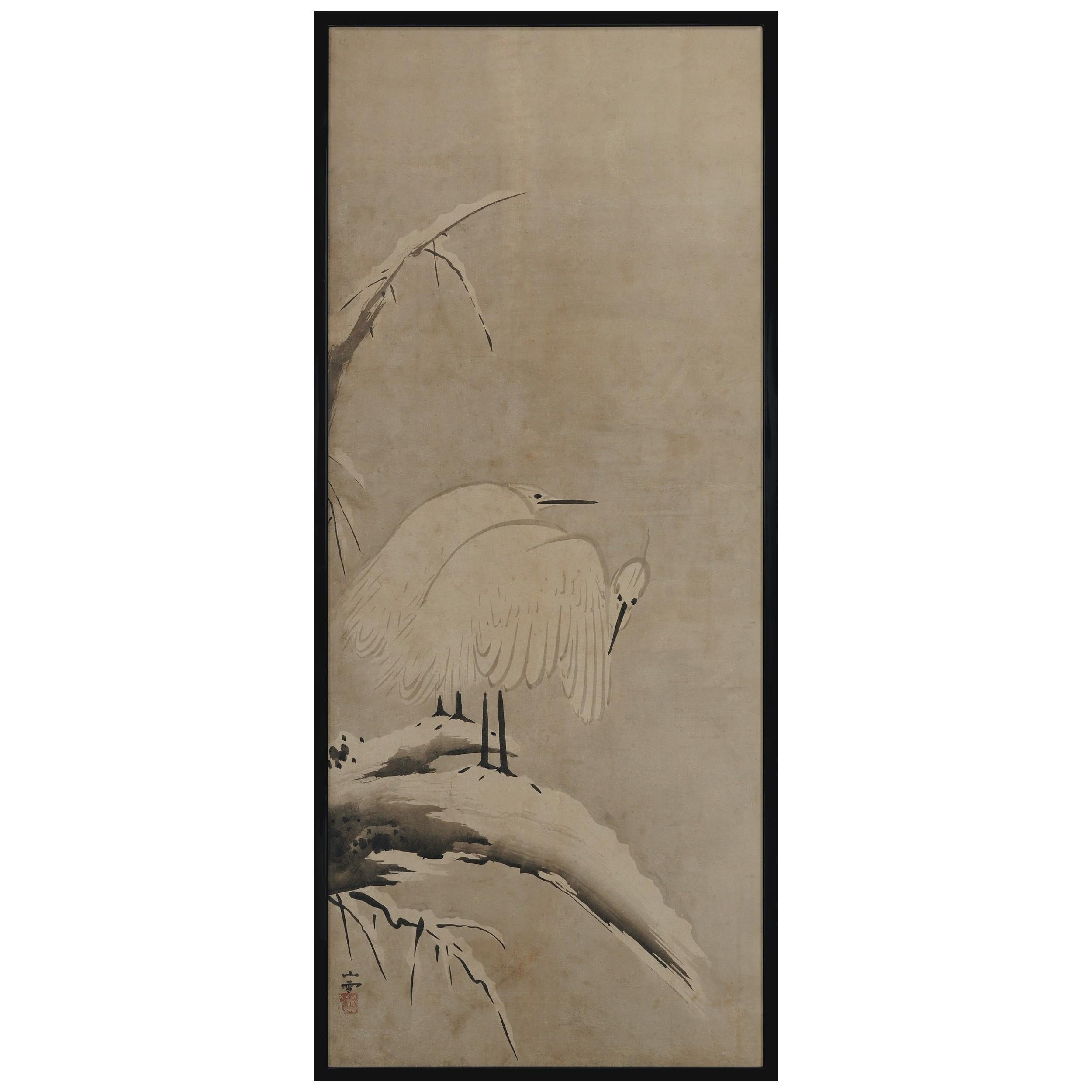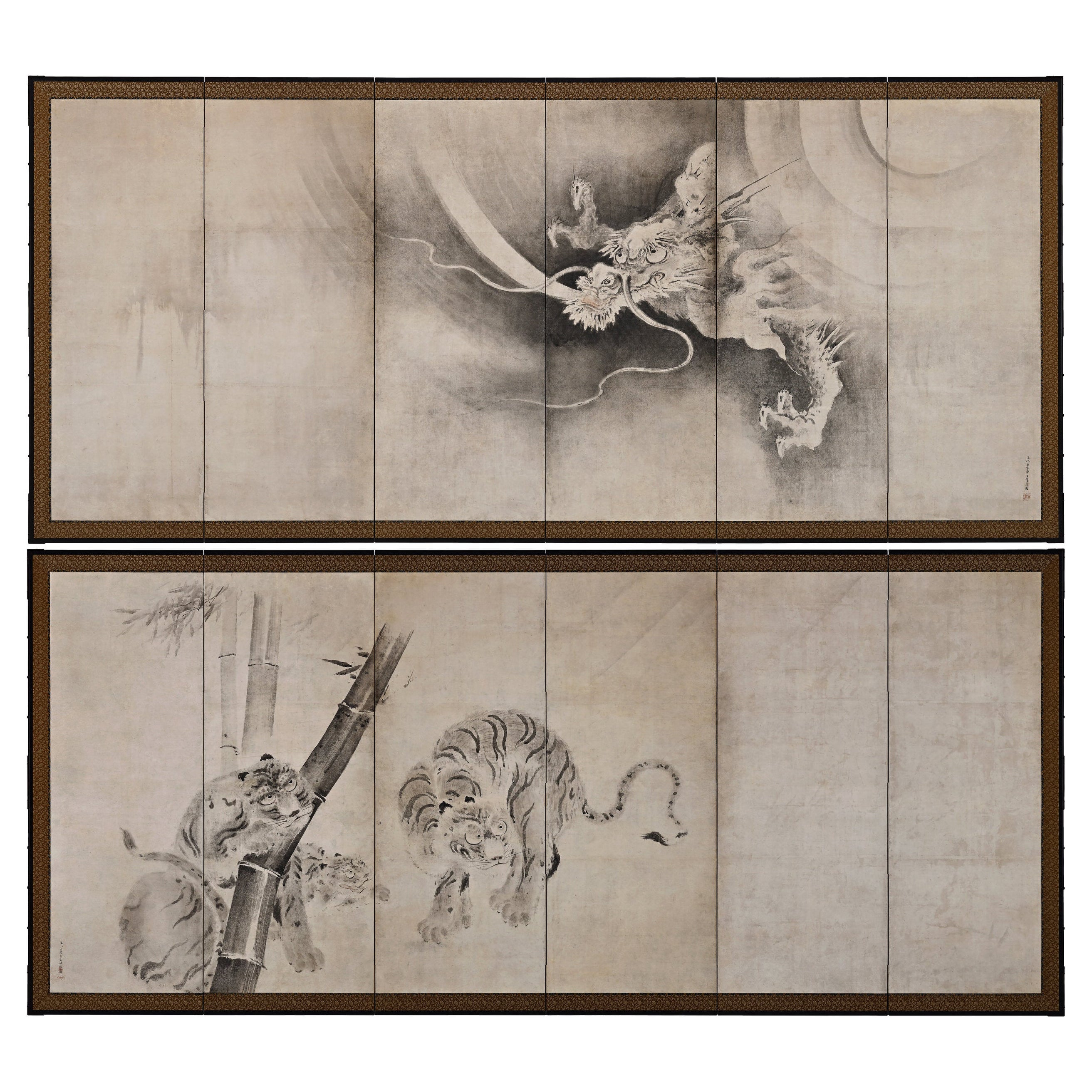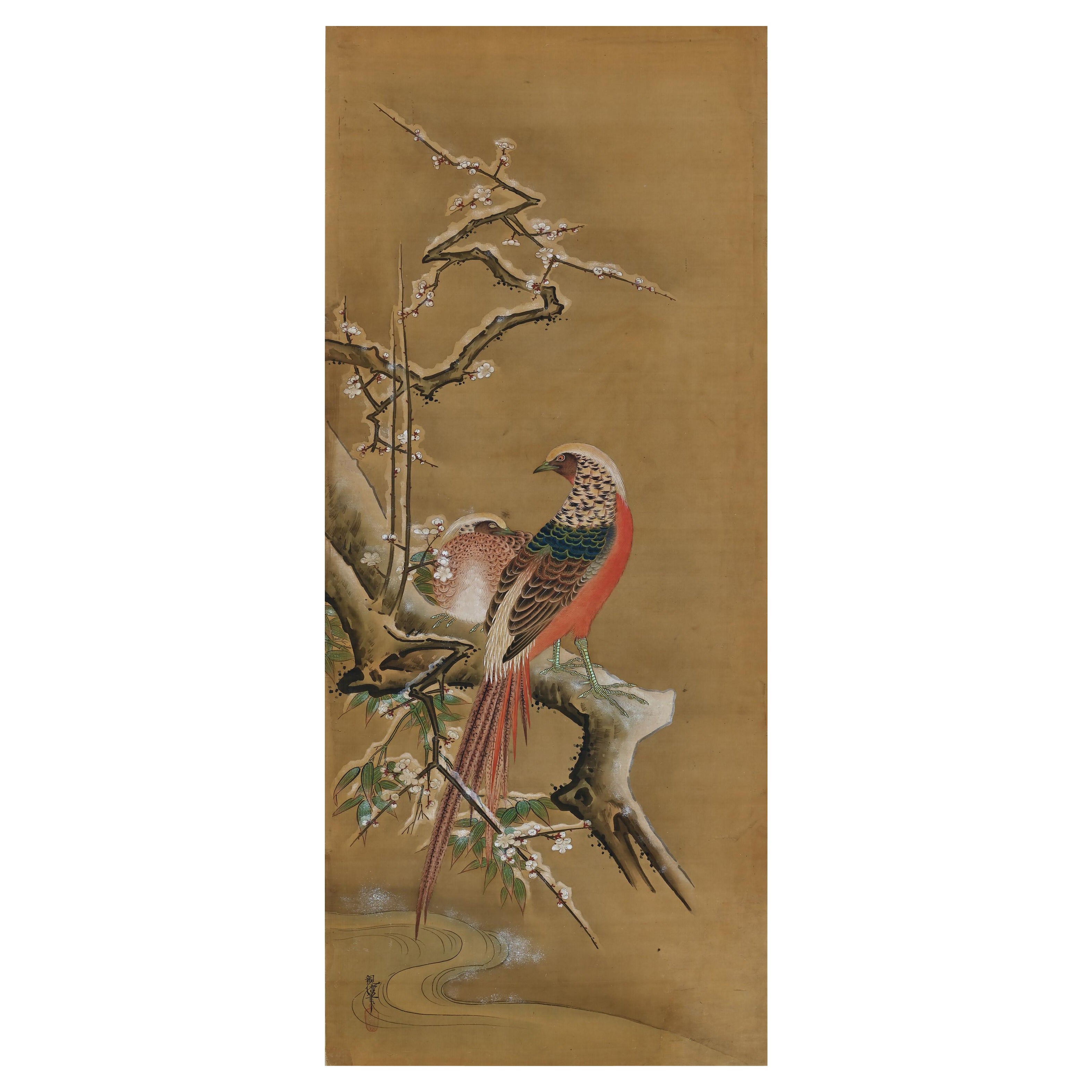Items Similar to 17th Century Japanese Screen. Ink Plum Tree & Birds by Kano Naonobu.
Want more images or videos?
Request additional images or videos from the seller
1 of 7
17th Century Japanese Screen. Ink Plum Tree & Birds by Kano Naonobu.
About the Item
Kano Naonobu (1607-1650)
Plum Tree and Birds
Six-fold Japanese Screen. Ink and slight color on paper.
In this evocative ink work spread over a six-panel folding screen, we see the consummation of the elegance and refinement of the Edo Kano school. This 17th century screen is a rare surviving example of a large-scale bird and flower painting by Kano Naonobu, the younger brother of Kano Tanyu. Closely related works are held in the Minneapolis Institute of Arts and the Cleveland Museum of Art. Kano Naonobu was the second son of Kano Takanobu (1571-1618). He was granted an estate in Edo in 1630. He became an official painter for the Shogunate and founder of the influential Kobikicho Kano family. The Kano were the most important family of professional painters in Japanese history. Stretching from the sixteenth to the twentieth century, the House of Kano served as official painters to the imperial and military elite for over four centuries. Naonobu produced a number of prominent commissions for the Shogunate including room partitions in Nagoya Castle. In Kyoto, he helped his brother with paintings for Nijō Castle and the major Pure Land Buddhist temple Chion’in.
His older brother Tanyu was a child prodigy and giant of Japanese art who laid the foundations for the Kano school’s dominance of Japan’s Edo period. Tan'yu made bold use of negative space to create his own unique world of simple elegance which was sensitively in tune with the demands of the era. Tanyu’s influence on his younger brother is undeniable but Naonobu’s delicate and lyrical ink paintings are outstanding. Even during his short lifetime his ink talents were praised over those of his brother. Naonobu seems to have inherited the tendency of painters of the previous era who found beauty in negative space, such as Hasegawa Tohaku and Kaiho Yusho, and to this he added elegance of expression. His works show individualism and originality even within the strict confines of the Kano school of the time, suggesting the form of the subject rather than delineating it. Although the screen presented here is a work of ink painting, the winter world of birds, blossoming plum trees and flowing water expressed by ink bleeding, scratching and stopping is already the realm of abstraction.
- Dimensions:Height: 65 in (165.1 cm)Width: 145 in (368.3 cm)Depth: 0.75 in (1.91 cm)
- Style:Edo (Of the Period)
- Materials and Techniques:
- Place of Origin:
- Period:
- Date of Manufacture:Circa 1640
- Condition:Refinished. Wear consistent with age and use. The screen has recently been completely remounted in Kyoto utilizing traditional craftsmen and techniques.
- Seller Location:Kyoto, JP
- Reference Number:1stDibs: LU2472332487722
About the Seller
5.0
Recognized Seller
These prestigious sellers are industry leaders and represent the highest echelon for item quality and design.
Established in 2001
1stDibs seller since 2016
60 sales on 1stDibs
Typical response time: 6 hours
- ShippingRetrieving quote...Ships From: Kyoto, Japan
- Return PolicyA return for this item may be initiated within 10 days of delivery.
More From This SellerView All
- 17th Century Japanese Framed Painting by Kano Sansetsu, Plum Blossoms in SnowLocated in Kyoto, JPKano Sansetsu (1589-1651) Plum blossoms in snow Edo period, circa 1640 Framed painting. Ink on paper. Kano Sansetsu is a Japanese painter who...Category
Antique 17th Century Japanese Edo Paintings and Screens
MaterialsPaper
- 17th Century Japanese Screen Pair by Soga Nichokuan, Hawks on Pine & Plum TreesLocated in Kyoto, JPHawks on plum and pine Soga Nichokuan (active circa 1625-1660) Pair of six-fold screens. Ink, mineral pigments, gofun, gold and speckled gold leaf on paper. Upper seal: H...Category
Antique 1640s Japanese Edo Paintings and Screens
MaterialsWood, Paper
- 17th Century Japanese Screen Pair, CranesLocated in Kyoto, JPCranes Anonymous, Kano School. Edo period, second half of the 17th century. Pair of six-panel screens. Ink, pigment gofun and gold l...Category
Antique 1670s Japanese Edo Paintings and Screens
MaterialsGold Leaf
- 17th Century Japanese Framed Panel by Kano Sansetsu, White Herons in SnowLocated in Kyoto, JPKano Sansetsu (1589-1651) White herons in snow Edo period, circa 1640 Framed painting. Ink on paper. Kano Sansetsu is a Japanese painter who ...Category
Antique 17th Century Japanese Edo Paintings and Screens
MaterialsPaper
- 17th Century Japanese Screen Pair. Tiger & Dragon by Kaiho YusetsuLocated in Kyoto, JPKaiho Yusetsu (1598-1677) Tiger and Dragon Early Edo Period, Circa 1650 A Pair of Six-fold Japanese Screens. Ink and slight color on paper. Dimensions: Each screen: H. 171 cm x W. 380 cm (67.5’’ x 149.5’’) In this pair of early Edo period Japanese screens a group of tigers prowl in a bamboo grove whipped with fierce wind, while a dragon claws through clouds and mist. The dragon embodies elemental qualities - looming out of the mist, the coils of its body disappearing in the clouds. The dragon is calling for rain, symbolizing spring which is considered the fountain of life. On the other side, the tigers calls for the wind, symbolizing autumn which is considered the end of life. Tigers were familiar motifs within Japanese art from ancient times though the animals were imaginary to the people in the 17th century. While dragons and tigers are usually associated as sacred and ferocious, in this painting, both animals have rather amusing expressions. The tigers appear to glare at the dragon with cat-like eyes, and the look on the swirling dragon’s face appears almost affectionate - lending a playful flair to an otherwise magnificent theme. The tiger and dragon are cosmological symbols of the balancing forces in the world. Screens such as this were originally meant to express the fluctuating nature of the world. For Japanese in the early Edo period, they likely suggested the powers of the cosmos. In Japan the tiger and dragon motif was originally absorbed into the circles of Zen monasteries before spreading into the secular world. The theme especially appealed to the military classes with the Kano school, the official painters to the Shogun and the samurai, being the leading contributors. The painter of this pair of screens, Kaiho Yusetsu (1598-1677), was closely patronized by the third Shogun Tokugawa Iemitsu. In his later years he worked with Kano school artists...Category
Antique Mid-17th Century Japanese Edo Paintings and Screens
MaterialsSilk, Wood, Paper
- 19th Century Japanese Silk Painting by Kano Chikanobu, Pheasants & Plum in SnowLocated in Kyoto, JPBirds & Flowers of the Seasons Pheasants & Plum in Snow Ink, pigment and gofun on silk Kano Chikanobu 1819-1888 Signature: Chikanobu Seal: Shateki Offered here is an unframed ‘kacho-e’ painting by the 19th century Japanese Takamatsu domain painter Kano Chikanobu. There are 8 individual paintings available, which originally would have been part of a set of 12. ‘Kacho-e’ literally means ‘pictures of birds and flowers’. In reality it covers a wide range of natural motifs including birds, fish, insects and small animals in combination with flowers, grasses or trees. The theme has a long history in Japanese painting. It is one of three painting genres, the other two being landscape and figure, which derive from Chinese academic painting classification. As one of the accepted types of painting to be shown in official residences, scenes of birds, flowers and animals were rife with metaphorical reference as well as physical beauty. In these paintings Chikanobu has made conspicuous use of brilliant pigments and meticulous brushwork. The rocks, water, trees, blossoms, and birds are treated as stylized formal elements in a grand design. All of the components contribute to the patterned effect and tactile richness of the surface. Beyond their highly decorative qualities, the subject of some of the paintings are also an allusion to imperial allegiance; the pheasants are symbolic of bravery and steadfastness, peacocks represent divinity and power, and the phoenix paired with paulownia a just and benevolent ruler. Cranes and turtles symbolize longevity, and the lush, full bloom of the peony flower represents wealth and opulence. Paintings of native Japanese birds and flowers were appreciated primarily for their evocation of the seasons and the traditional poetic emotions associated with them. This is the case with the spring scene of cherry blossoms and birds and the winter scene of narcissus, nandina and sparrows. The rich expression of flower and bird paintings...Category
Antique Mid-19th Century Asian Edo Paintings and Screens
MaterialsSilk
You May Also Like
- 17th Century Japanese Two-Panel Screen, Gibbons of FolkloreLocated in Hudson, NYJapanese two-panel screen: Gibbons of Folklore, Edo period (17th century) Kano School painting of gibbons in Japanese fables. The left panel represents a Japanese fable of a monkey a...Category
Antique Late 17th Century Japanese Edo Paintings and Screens
MaterialsSilk, Wood, Paper
- 19th Century Japanese Edo Six Panel Kano School Landscape ScreenLocated in Rio Vista, CALate Edo period 19th century Japanese six-panel landscape screen featuring a cypress tree over a flowering hibiscus with a pair of hototogisu birds. Kano school painted with ink and ...Category
Antique 19th Century Japanese Edo Paintings and Screens
MaterialsSilk, Wood, Paper
- 18th Century Japanese Kano School Landscape ScreenLocated in Prahran, VictoriaJapanese Kano school screen with pine tree, camellias, cherry blossom and Chinese figures in the landscape, circa 18th century. Materials: Pigmen...Category
Antique 18th Century Japanese Paintings and Screens
MaterialsSilver Leaf
- Antique Japanese Suibokuga Egrets by Kano Tokinobu, 17th century.Located in Point Richmond, CAAntique Japanese Suibokuga Egrets by Kano Tokinobu, 17th century. A sumi-e ink on paper painting illustrating two egrets in reserve with no outlines contrasting with the reeds from the marsh in the background. The painting with 3 vermillion seals of the artist in the lower left corner. Japanese dry mount paper on a wood frame with thin brocade border silver leafed surround and lacquered wood outer frame. Condition: Lighter discoloration on the lower portion of the painting, other minor signs of age, wear, stains and repairs otherwise fine condition. Age: Painting Edo Period, circa 1670. Mounting circa 1985. Image: 51-1/2 in. x 20-1/2 in. (131cm x 52cm) Frame 59-1/4 in. x 25-1/4 in. (150cm x 64cm) Weight: 6 lbs. Provenance: with Honeychurch Antiques...Category
Antique 1670s Japanese Edo Paintings and Screens
MaterialsPaper
- Antique Japanese Suibokuga Landscape by Kano Tokinobu, 17th century.Located in Point Richmond, CAAntique Japanese Suibokuga Landscape by Kano Tokinobu, 17th century. A sumi-e ink on paper painting illustrating a rocky seaside landscape containing buildings, vegetation and ship masts. The painting with 3 vermillion seals of the artist in the lower left corner. Japanese dry mount paper on a wood frame with thin brocade border silver leafed surround and lacquered wood outer frame. Condition: Lighter discoloration near the bottom of the painting, various paper restorations, other minor signs of age, wear, stains, otherwise fine condition. Age: Painting Edo Period, circa 1670. Mounting circa 1985. Image: 51-1/2 in. x 20-1/2 in. (131cm x 52cm) Frame: 59-1/4 in. x 25-1/4 in. (150cm x 64cm) Weight: 6 lbs. Provenance: with Honeychurch Antiques...Category
Antique 1670s Japanese Edo Paintings and Screens
MaterialsPaper
- Antique Japanese Suibokuga Landscape by Kano Tokinobu, 17th century.Located in Point Richmond, CAAntique Japanese Suibokuga Landscape by Kano Tokinobu. 17th century. A sumi-e ink on paper painting illustrating an ethereal mountainous landscape at the seashore containing buildings, trees, birds and ship masts. 3 vermillion seals of the artist in the lower right hand corner. Japanese dry mount paper on a wood frame with thin brocade border silver leafed surround and lacquered wood outer frame. Condition: Minor signs of age, wear, otherwise fine condition. Age: Painting Edo Period, circa 1670. Mounting circa 1985. Image: 51-1/2 in. x 20-1/2 in. (131cm x 52cm) Frame: 59-1/4 in. x 25-1/4 in. (150cm x 64cm) Weight: 6 lbs. Provenance: with Honeychurch Antiques...Category
Antique 1670s Japanese Edo Paintings and Screens
MaterialsPaper
Recently Viewed
View AllMore Ways To Browse
Japanes Birds
Japanese Birds
Large Wood Trees
Japanese Influence Furniture
17th Century Birds
Large Screen Panel
Six Fold
Room Partition
Antique Paper Paint Color
17th Century Wood Panels
Used Room Partitions
Painting Of Woods And Trees
Japan Ink Wood
Japanese Painting With Birds
Military Commission
Antique Negatives
Japanese Screens Four
Asian Water Colour





